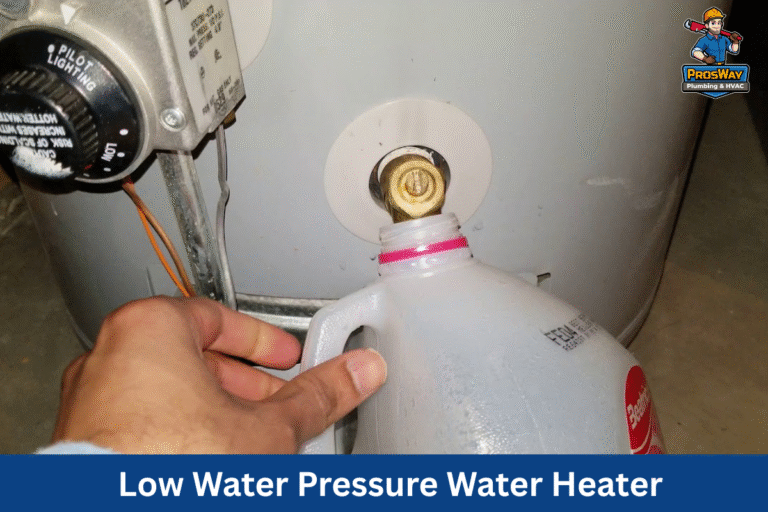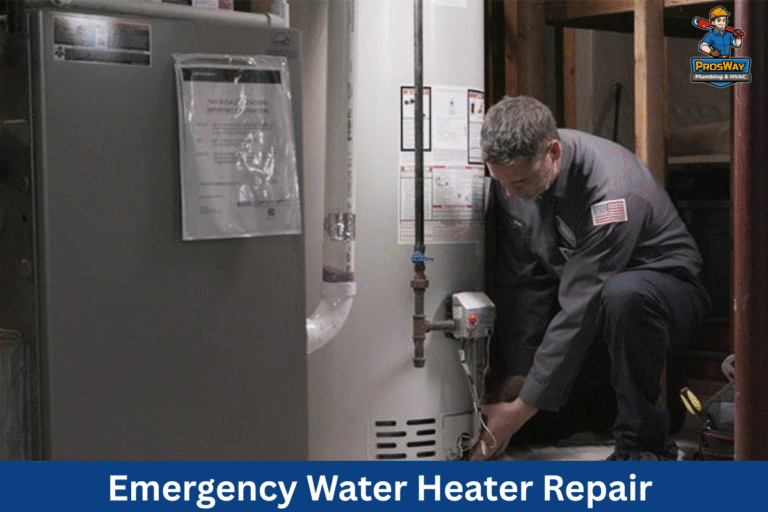At ProsWay Plumbing & HVAC, we’ve seen how common—and costly—sewer backups can be for Northern New Jersey homeowners. Blocked lines, tree roots, and aging pipes are just a few culprits that can cause wastewater to flow back into your home.
This guide breaks down the top causes of backups and how to prevent them. With local insight and proven solutions, we’ll help you protect your property, save on repairs, and keep your plumbing running smoothly.
What Causes Sewer Backups You Should Be Aware Of?
Sewer backups primarily occur when the waste and water flow through pipes faster than the system can handle, causing blockages. There are several underlying causes behind these clogs.

Common Blockages That Trigger Sewer Backups
Often, the root problem is not a single incident but a combination of factors that accumulate over time. Homeowners who experience issues may find that diverse elements contribute to sewer backups.
Such as solid waste blockages, tree root intrusion, structural damage, heavy rainfall, and aging sewer systems. Many sewer blockages happen because people flush non-degradable items that congeal and build up inside pipes.
Food waste, hygiene products like wipes that do not break down, and even excessive toilet paper can cause significant issues. Additionally, debris in the sewer system, such as grease and sediment, can form a hard mass that narrows the diameter of your main sewer line.
This blockage prevents the free movement of sewage and eventually leads to backflow. Data from local municipalities indicate that properties with older cast iron pipes are especially vulnerable due to corrosion.
What Structural and Environmental Factors Contribute to Sewer Backups?
Another common cause is the intrusion of tree roots. Trees and shrubs naturally search for moisture, causing their roots to invade sewer lines through any small cracks or joint failures.
Once inside, these roots grow, exacerbating clogs and even breaking open the pipe. This problem is widespread in neighborhoods where mature trees are abundant.
In our experience servicing Northern New Jersey, many homeowners have faced repeated issues due to roots from large oak and maple trees actively seeking water sources.
Structural damage to sewer pipes is another significant contributor. Pipes may shift or become damaged due to ground movement, foundation settling, or material deterioration over decades.
Even a small crack in a pipeline can allow groundwater to seep in, adding more water to the load and increasing the risk of a backup during heavy rain.
Municipal records show that old clay pipes, once common in residential construction, now pose a high risk due to their brittleness and vulnerability to damage.
When large amounts of water enter the system at once, the pipes may not have the capacity to transport it all away from residential areas. This leads to water backing up into properties, especially those with already compromised sewer lines.
In urban areas, stormwater and sewage are often combined in one system, and during a heavy storm, this combined flow can easily exceed. Finally, aging sewer infrastructure is a crucial aspect.
Many older neighborhoods still rely on sewer systems that have not been updated or properly maintained for decades. These systems are prone to cracks, blockages, and inefficiencies, making them susceptible to backups.
Regular inspections and sewer line maintenance are necessary, but in regions with budget constraints or outdated municipal planning, these issues persist, leading to recurring backups over the years.
Proactive measures, such as regular inspections and professional cleaning, can help identify potential issues before they turn into emergency situations.
Homeowners should consider scheduled maintenance with experts like Plumbing services, sewer line repair, to avoid costly repair bills and ensure a safe living environment.
To help you visualize the causes, the table below compares the primary factors contributing to sewer backups.
| Cause | Common Indicators | Contributing Factors | Potential Repairs |
|---|---|---|---|
| Solid Waste Blockages | Slower drainage, gurgling sounds | Non-degradable waste, grease build-up | Drain cleaning, pipe snaking |
| Tree Root Intrusion | Recurring clogs, visible root growth | Invasive roots, cracked pipes | Root removal, pipe replacement |
| Structural Damage | Leaks, visible cracks on pipes | Corrosion, ground movement | Pipe repair or replacement |
| Heavy Rainfall Overload | Flooding, basement backups | Excess stormwater, combined sewer systems | Upgrading drainage systems, backwater valves |
| Aging Sewer Infrastructure | Frequent backups, low water flow | Outdated materials, lack of maintenance | System overhaul, pipe replacement |
Warning Signs of a Sewer Backup
Recognizing the early signs of a sewer backup is critical in preventing long-term damage to your property. The first clear signals are slow-draining sinks and toilets.
When water takes much longer than usual to flow down the drain, it is often an indicator that a blockage is forming somewhere in your piping system.
What Should You Look For Inside Your Home?
In many cases, a minor clog at the main sewer line can disrupt the entire flow and lead to more severe issues if not addressed promptly. Gurgling sounds from your drains are another warning sign.
These unusual noises occur when air is forced through a partially clogged pipe. They are a signal that there is a disruption in the normal flow of water and sewage. When you hear persistent gurgling, it is time to take a closer look at your pipes.
Unpleasant odors emanating from pipes further confirm that a sewer problem is imminent. Foul smells are a symptom of stagnant water and decaying waste that is not being effectively flushed away, often due to a blockage.
The odor may seep into your living spaces, particularly if the backup is causing pressure to build up in the plumbing system. This toxic exposure can compromise indoor air quality and potentially harm your health.
Water backing up in unexpected places is a more severe indicator. If you begin to see water pooling in areas away from the main drainage outlet. Such as in your bathtub, under sinks, or even in your basement, it signifies that the blockage is overwhelming the normal flow path.
Such backups indicate that the sewage is being forced back through your pipes, creating a hazardous environment. Multiple fixture drainage problems highlight that the issue is affecting the entire plumbing system.
When several fixtures show signs of slow drainage simultaneously, the blockage or failure is likely located at the main sewer line. This situation requires immediate attention because it affects the whole structure’s drainage capacity.
What Signs Should You Watch for Outside Your Home?
In addition to these internal symptoms, you may notice signs outside your property. For example, unusually lush patches of vegetation near your sewer line could suggest a leak, providing extra water for plant growth.
Similarly, patchy or soggy lawns might indicate a system problem due to a pipe crack. Watch this video for more information: Sewer Backup Warning Signs: Don’t Ignore These Red Flags!
Paying attention to these signs and acting quickly by calling a professional plumber can save you from extensive damage. Regular inspections can help identify these concerns early.
Homeowners in Northern New Jersey should consider routine maintenance checks with specialists like ProsWay Plumbing & HVAC to ensure any emerging issues are fixed before they lead to a full-blown sewer backup.
Summary
Below is a detailed list that summarizes the early warning signs of a sewer backup:
- Slow Draining Sinks and Toilets – These indicate potential clogs or blockages forming in the main sewer line that may worsen over time.
- Gurgling Sounds From Your Drains – Unusual noises signal trapped air due to restricted flow, often a precursor to full backups.
- Unpleasant Odors Emanating From Pipes – Foul smells suggest the presence of stagnant waste and possible contamination.
- Water Backing Up in Unexpected Places – Returns in bathtubs, sinks, or basements point to a severe blockage.
- Multiple Fixture Drainage Problems – Simultaneous issues in several fixtures imply a blockage in the main sewer lateral.
- Lush Vegetation or Soggy Lawns Near Sewer Lines – External signs of leaks can indicate underlying drainage issues.
- Visible Debris or Foul Residue Around Pipes – Noticing buildup or residue on pipes can hint at solid waste accumulation.
What Are the Most Effective Ways to Prevent Sewer Backups?
Preventing sewer backups is a matter of routine maintenance, proper usage of your plumbing system, and timely professional intervention. One effective strategy involves practicing proper waste disposal habits.
Avoid flushing items that are not designed to be dissolved, such as baby wipes, feminine hygiene products, and chemicals. When non-degradable materials enter the sewer line, they form blockages over time.
In addition, educating household members about the proper disposal of food waste and grease is vital. These substances can solidify along the pipes, narrowing the flow and leading to backups.
What Maintenance Habits Help Prevent Sewer Issues?
Implementing regular drain cleaning is another essential method to maintain a healthy sewer system. Professional drain cleaning services remove grease, debris, and small obstructions that accumulate over time.
Using enzyme-based drain cleaners can be helpful because they naturally break down waste without harming the pipes. As a homeowner, it is beneficial to have your drains inspected and cleaned at least once a year to prevent buildup.
Managing tree roots near sewer lines is also critical. As discussed earlier, roots can infiltrate pipes and cause significant obstructions. Strategic trimming of tree roots near your property and the use of root barriers can hinder their growth into the sewer system.
In some cases, a professional plumber might recommend a chemical treatment to prevent roots from invading further. This is especially important for properties with mature landscaping where the likelihood of tree root intrusion is high.
What Proactive Measures Can Protect Your Plumbing System?
Scheduling professional sewer line inspections is another proactive measure. Experienced plumbers use cameras to inspect the inside of your pipes, accurately detecting blockages, cracks, or other issues.
Regular inspections can reveal small issues that, if left unchecked, could lead to a complete sewer backup. Many homeowners forget that sewage systems are like any other infrastructure in the home that requires upkeep.
Another key preventive strategy is to consider installing a backwater prevention valve. This device is designed to automatically block wastewater from flowing back into your home in the event of an overload.
When installed correctly, the valve only allows water to flow in one direction—away from your house. This solution is particularly effective during heavy rains or municipal system overflows.
The use of backwater prevention valves is a proven method, especially in areas prone to frequent flooding or where the municipal sewer system struggles during storms.
Best Practices for Preventing Sewer Backups
To support these practices further, consider the following best practices for preventing sewer backups:
- Practice Proper Waste Disposal Habits – Avoid flushing non-degradable items and dispose of grease and chemicals properly.
- Implement Regular Drain Cleaning – Schedule annual drain cleaning to remove buildup and detect potential issues early.
- Manage Tree Roots Near Sewer Lines – Trim and treat tree roots to prevent them from infiltrating your pipes.
- Schedule Professional Sewer Line Inspections – Use camera inspections to monitor the condition of your sewer lateral and main lines.
- Consider installing a Backwater Prevention Valve – Invest in a valve that automatically stops wastewater from flowing back into your home.
- Avoid Overloading the System During Heavy Rainfall – Use additional water-saving measures during storms to reduce stress on the system.
- Educate Household Members on Plumbing Practices – Ensure everyone in the home understands how to use the plumbing system correctly to avoid clogging it.
Below is a table that summarizes these prevention strategies:
| Strategy | Key Action Item | Expected Outcome | Typical Cost Range |
|---|---|---|---|
| Proper Waste Disposal | Avoid non-degradable materials | Reduces solid waste buildup | Minimal (behavioral change) |
| Regular Drain Cleaning | Annual professional cleaning | Prevents grease and debris accumulation | $150–$300 per cleaning |
| Tree Root Management | Use root barriers and trimming | Minimizes pipe invasion by roots | $200–$500 per treatment |
| Professional Sewer Line Inspections | Use camera-based inspection | Early detection of cracks or blockages | $100–$250 per inspection |
| Backwater Prevention Valve Installation | Install a check valve | Blocks sewer backflow during overflows | $800–$1,500 installation |
| System Overload Management | Reduce water usage during storms | Decreases strain on the sewer system | Minimal (behavioral change) |
| Homeowner Education | Inform the household on proper plumbing use | Preventative maintenance by avoiding misuse | Minimal (internal training) |
What Steps Should You Take if You Experience a Sewer Backup?

If you experience a sewer backup, it is critical to act quickly to minimize damage and health risks. The first step is to ensure safety by avoiding contact with the wastewater, which can contain harmful bacteria and viruses.
Always wear protective clothing, including gloves and boots, and ensure proper ventilation before you begin any examination or cleanup. Disconnecting electrical appliances in the affected area is also advised to of electrical shock.
What Should You Do Immediately After a Sewer Backup?
Once safety is ensured, document the damage for insurance purposes. Take clear photos and detailed notes of the affected areas, including the water level and any items that have been ruined by the floodwater.
This documentation will be helpful when filing an insurance claim and can provide evidence for from your plumber. Next, arrange for professional cleanup and restoration. Sewer backups require specialized equipment and expertise.
Professional cleaning services use industrial-grade equipment to remove contaminated water and safely dispose of the sewage. They also disinfect affected areas to prevent mold growth and the spread of bacteria.
Given the potential for long-term damage and health risks, professional remediation is often the best solution. It is essential to hire a reputable service in both plumbing repair and environmental cleanup.
What Follow-Up Actions Help Prevent Future Issues?
After cleanup, it is important to call a professional plumber to address the root cause of the backup. Do not attempt to repair the problem yourself if you are not experienced with sewage systems.
A professional plumber can determine whether the blockage is due to solid waste, tree roots, structural damage, or another issue. Finally, report the incident to the relevant authorities if the backup is due to a municipal issue.
Notifying your local water treatment or municipal sewer system agency can help them investigate widespread problems that might be affecting other residents.
Step-By-Step Guide
This proactive step helps to address the immediate problem and prevent similar incidents in your community in the future. Below is a step-by-step list detailing what to do during a sewer backup:
- Ensure Safety and Minimize Health Risks – Wear protective clothing and avoid contact with wastewater.
- Document the Damage – Take clear photos and detailed notes for insurance and repair estimates.
- Arrange for Professional Cleanup and Restoration – Hire cleanup professionals with expertise in handling contaminated water.
- Call a Professional Plumber – Have an expert assess and repair the root cause of the blockage.
- Report the Incident to Municipal Authorities – Notify local agencies if widespread issues are suspected.
- Ventilate and Dry the Affected Area – Use fans and dehumidifiers to aid in drying and prevent mold growth.
- Review Preventive Measures – After cleanup, implement strategies to prevent future backups.
Following these steps carefully is crucial to limiting the damage caused by a sewer backup and protecting both your property and health.
Professional intervention is always recommended, as improper cleanup can lead to additional issues such as mold or lingering contaminants.
In conjunction with these steps, consider arranging a thorough of your plumbing system to identify and fix vulnerabilities that may predispose your home to future backups.
Frequently Asked Questions
How do I know if my sewer backup is due to a blockage in my pipes?
Slow-draining sinks, multiple fixtures experiencing drainage issues, and unusual gurgling sounds are common indicators that your pipes might be blocked.
If you observe these symptoms along with unpleasant odors, it is likely that a solid waste blockage or grease buildup is causing a backup. Regular inspections can help you detect and address these issues early.
What immediate steps should I take if I experience a sewer backup in my home?
First, ensure that all family members are safe by avoiding contact with the contaminated water and wearing protective gear if needed.
Document the damage with photos, then contact professional cleanup and restoration services. It’s also important to call a licensed plumber to evaluate and fix the root cause of the backup.
How can I prevent sewer backups from recurring?
Preventing sewer backups involves a combination of good maintenance practices and professional services. Regular drain cleanings and installing backwater prevention valves are all effective strategies.
Additionally, managing tree roots and enhancing property drainage can reduce the overall burden on your sewer system during heavy rainfall.
What long-term solutions can help reduce the risk of sewer backups in older homes?
Long-term solutions include replacing outdated or damaged sewer lines with modern materials like PVC, utilizing hydro jetting services to clear stubborn clogs, and improving property drainage through sump pump installation.
Regular professional inspections also play a key role in detecting potential issues before they lead to complete breakdowns. These measures combined help create a more resilient sewer system.
Final Thoughts
Addressing the common causes of sewer backups is crucial for protecting your home. Identifying blockages and updating aging infrastructure all contribute to a well-maintained sewer system. Preventative measures—from regular drain cleaning to installing backwater valves—are essential steps that can save you from costly repairs. We encourage homeowners to partner with local experts to safeguard their property.
Dealing with Sewer Backups? Let ProsWay Handle It!
Sewer backups can be messy and stressful, but you don’t have to face them alone. ProsWay Plumbing & HVAC offers fast, reliable solutions to identify the cause and restore your plumbing system. Call us now at (862) 260-5870 or Book Online today for expert help and peace of mind!









